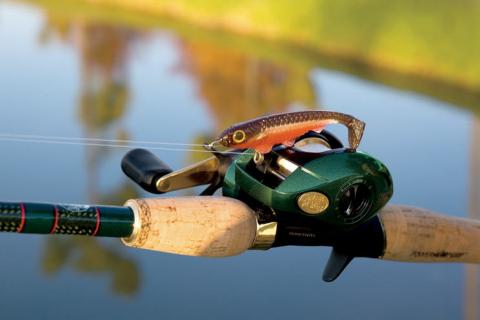
The technology behind fishing reels is always changing, with new drag settings and anti-backlash features, but the styles of reels are timeless. Any angler will probably have a favorite type of reel, and a lot of what makes that preference is what feels best—and sometimes what you’re fishing for. Whatever you learn first might be what you use, but every reel has its own benefits if you’re willing to give them a chance.

as they begin to learn how to fish.
Learn About Spincasting Reels
Spincast reel is also known as a closed face reel. This is the kind of reel most young anglers use when they learn to fish. You’ll often see Mickey Mouse’s face on these—at least the ones for the kids—but spincast reels serve perfectly well once an angler gets more experienced, too. It’s insanely easy to use: Just press and hold the button, rear back to cast, and as you’re moving forward, let go of the button. If you need to stop your cast from going further, you can just hit the button again.
The friction from the closed face of a spincast reel prevents the line from having the freedom to travel as far as it might in an open-faced reel, like a spinning or baitcasting reel. And in general, the fact that the line is enclosed means that the spool is smaller, letting you carry less in the first place. If you plan to cast into wide-open water, though, a spincast does just fine.

line and allow for longer casts than
spinning gear in the same size range
Get to Know Baitcasting Reels
You’ll often hear stories about baitcasting reels and birds nests used in the same sentence. These are usually big, open-faced reels that are great for heavier-pound test line and casting heavier lures. Once you’ve mastered them, they’re probably the most accurate fishing reels you can use. They’re popular for anything from largemouth to catfish to saltwater fishing.
Usually, it’s only folks who have been fishing for quite a while who use baitcasters, specifically because of their tendency to backlash. It takes a lot of practice to get used to using your thumb to control the spool, but the payoff for all the practice is worth it.

for smaller tackle used to catch panfish
to much larger tackle used to catch bull
reds.
Understanding Spinning Reels
A Spinning reel is also known as an open face reel. These may be the most popular fishing reels used today. They’re easy to use and, because they come in a variety of sizes, they’re versatile. Backlash isn’t an issue with spinning reels like it is with baitcasters, and they’re far more accurate than a spincast. If you need to change line quickly, you can often buy an additional spool that you can have wound and ready to swap out with a couple of clicks.
Spinning reels aren’t usually made to handle overly heavy pound test, but most will still perform just fine up to about 20. And while backlash isn’t a problem, twists in your line can be. You may even see a few loose loops occasionally. These aren’t big problems, usually, and this is a major reason why spinning reels are among the favorites of so many anglers.
Watch Video: How to Spool a Spinning Reel

spare spool and match up the fly line weight
with the fly reel weight.
The Basic Attributes of a Fly Fishing Reel
A fly fishing reel is a bit different than the other fishing reels listed above. Instead of being used to reel the fish in, they’re meant primarily to hold line and provide drag as the fish runs.
You won’t be swapping out any of the above reels with a fly reel, but fly fishing provides plenty of its own fun. Look for a fly reel that’s not going to rust if it gets wet, that’s built well (don’t be afraid to splurge), and that has a disc-drag system.
Fly reels (like all reels) are designed to carry a specific weight of line. If you’re using 6-weight line, get a reel that is built for it.
- 50232 views

